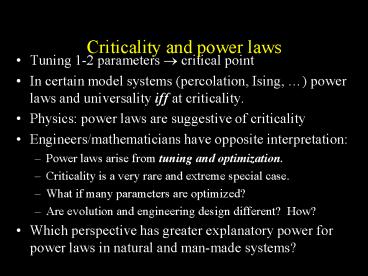Criticality and power laws
1 / 34
Title:
Criticality and power laws
Description:
HOT yields compact events of nontrivial size. SOC has infinitesimal, fractal events. ... Compact. Fractal. Large event shape. Large. Infinitesimal. Max event ... –
Number of Views:39
Avg rating:3.0/5.0
Title: Criticality and power laws
1
Criticality and power laws
- Tuning 1-2 parameters ? critical point
- In certain model systems (percolation, Ising, )
power laws and universality iff at criticality. - Physics power laws are suggestive of criticality
- Engineers/mathematicians have opposite
interpretation - Power laws arise from tuning and optimization.
- Criticality is a very rare and extreme special
case. - What if many parameters are optimized?
- Are evolution and engineering design different?
How? - Which perspective has greater explanatory power
for power laws in natural and man-made systems?
2
6
Data compression (Huffman)
WWW files Mbytes (Crovella)
5
4
Cumulative
3
Frequency
Forest fires 1000 km2 (Malamud)
2
1
0
-1
-6
-5
-4
-3
-2
-1
0
1
2
Decimated data Log (base 10)
Size of events
3
Size of events x vs. frequency
log(Prob gt size)
log(rank)
log(size)
4
6
Web files
5
Codewords
4
Cumulative
3
Frequency
Fires
2
1
0
-1
-6
-5
-4
-3
-2
-1
0
1
2
Size of events
Log (base 10)
5
Forest fires dynamics
Intensity Frequency Extent
6
A HOT forest fire abstraction
Fire suppression mechanisms must stop a 1-d front.
Optimal strategies must tradeoff resources with
risk.
7
Generalized coding problems
- Optimizing d-1 dimensional cuts in d dimensional
spaces - To minimize average size of files or fires,
subject to resource constraint. - Models of greatly varying detail all give a
consistent story. - Power laws have ? ? 1/d.
- Completely unlike criticality.
Data compression
Web
8
Theory
d 0 data compression d 1 web layout d
2 forest fires
9
Data
6
DC
5
WWW
4
3
FF
2
1
0
-1
-6
-5
-4
-3
-2
-1
0
1
2
10
Data Model/Theory
6
DC
5
WWW
4
3
FF
2
1
0
-1
-6
-5
-4
-3
-2
-1
0
1
2
11
Forest fires?
Fire suppression mechanisms must stop a 1-d front.
12
Forest fires?
Geography could make d lt2.
13
California geographyfurther irresponsible
speculation
- Rugged terrain, mountains, deserts
- Fractal dimension d ? 1?
- Dry Santa Ana winds drive large (? 1-d) fires
14
Data HOT Model/Theory
6
5
California brushfires
4
3
FF (national) d 2
2
1
0
-1
-6
-5
-4
-3
-2
-1
0
1
2
15
Data HOTSOC
6
5
4
3
2
1
0
-1
-6
-5
-4
-3
-2
-1
0
1
2
16
Critical/SOC exponents are way off
Data ? gt .5
SOC ? lt .15
17
18 Sep 1998
Forest Fires An Example of Self-Organized
Critical Behavior Bruce D. Malamud, Gleb Morein,
Donald L. Turcotte
4 data sets
18
HOT FF d 2
2
10
1
10
0
10
-2
-1
0
1
2
3
4
10
10
10
10
10
10
10
Additional 3 data sets
19
(No Transcript)
20
Fires 1930-1990
Fires 1991-1995
21
HOT
SOC and HOT have very different power laws.
d1
SOC
d1
- HOT ? decreases with dimension.
- SOC?? increases with dimension.
22
- HOT yields compact events of nontrivial size.
- SOC has infinitesimal, fractal events.
HOT
SOC
large
infinitesimal
size
23
SOC and HOT are extremely different.
HOT
SOC
24
SOC and HOT are extremely different.
HOT
SOC
25
Robust
Log(freq.) cumulative
yet fragile
Log(event sizes)
26
Power laws are inevitable.
Gaussian
log(probgtsize)
log(size)
27
Power laws summary
- Power laws are ubiquitous
- HOT may be a unifying perspective for many
- Criticality, SOC is an interesting and extreme
special case - but very rare in the lab, and even much rarer
still outside it. - Viewing a complex system as HOT is just the
beginning of study. - The real work is in new Internet protocol design,
forest fire suppression strategies, etc
28
Universal network behavior?
Congestion induced phase transition.
throughput
- Similar for
- Power grid?
- Freeway traffic?
- Gene regulation?
- Ecosystems?
- Finance?
demand
29
Web/Internet?
30
Networks
- Making a random network
- Remove protocols
- No IP routing
- No TCP congestion control
- Broadcast everything
- ? Many orders of magnitude slower
log(thru-put)
log(demand)
31
Networks
HOT
log(thru-put)
log(demand)
32
Complexity, chaos and criticality
- The orthodox view
- Power laws suggest criticality
- Turbulence is chaos
- HOT view
- Robust design often leads to power laws
- Just one symptom of robust, yet fragile
- Shear flow turbulence is noise amplification
- Other orthodoxies
- Dissipation, time irreversibility, ergodicity and
mixing - Quantum to classical transitions
- Quantum measurement and decoherence
33
Epilogue
- HOT may make little difference for explaining
much of traditional physics lab experiments, - So if youre happy with orthodox treatments of
power laws, turbulence, dissipation, quantum
measurement, etc then you can ignore HOT. - Otherwise, the differences between the orthodox
and HOT views are large and profound,
particularly for - Forward or reverse (eg biology) engineering
complex, highly designed or evolved systems, - But perhaps also, surprisingly, for some
foundational problems in physics
34
Data Model/Theory
6
DC
5
WWW
4
3
FF
2
1
0
-1
-6
-5
-4
-3
-2
-1
0
1
2































